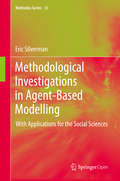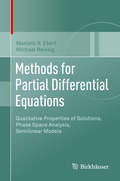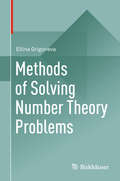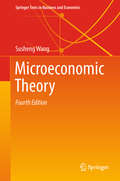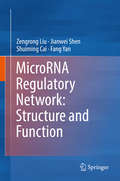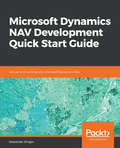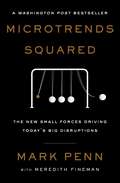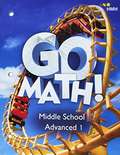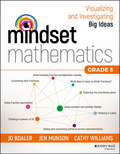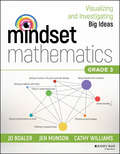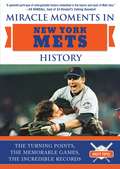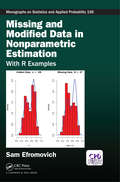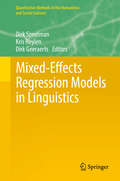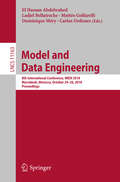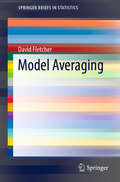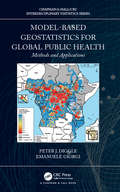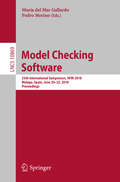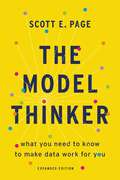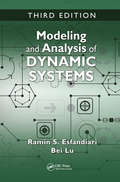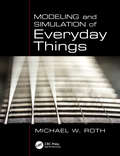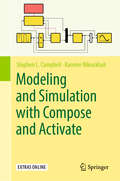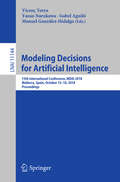- Table View
- List View
Methodological Investigations in Agent-Based Modelling: With Applications For The Social Sciences (Methodos Ser. #13)
by Eric Silverman Daniel Courgeau Robert Franck Jakub Bijak Jason Hilton Jason Noble John BrydenThis open access book examines the methodological complications of using complexity science concepts within the social science domain. The opening chapters take the reader on a tour through the development of simulation methodologies in the fields of artificial life and population biology, then demonstrates the growing popularity and relevance of these methods in the social sciences. Following an in-depth analysis of the potential impact of these methods on social science and social theory, the text provides substantive examples of the application of agent-based models in the field of demography. This work offers a unique combination of applied simulation work and substantive, in-depth philosophical analysis, and as such has potential appeal for specialist social scientists, complex systems scientists, and philosophers of science interested in the methodology of simulation and the practice of interdisciplinary computing research.
Methods for Partial Differential Equations: Qualitative Properties Of Solutions, Phase Space Analysis, Semilinear Models
by Marcelo R. Ebert Michael ReissigThis book provides an overview of different topics related to the theory of partial differential equations. Selected exercises are included at the end of each chapter to prepare readers for the “research project for beginners” proposed at the end of the book. It is a valuable resource for advanced graduates and undergraduate students who are interested in specializing in this area.The book is organized in five parts:In Part 1 the authors review the basics and the mathematical prerequisites, presenting two of the most fundamental results in the theory of partial differential equations: the Cauchy-Kovalevskaja theorem and Holmgren's uniqueness theorem in its classical and abstract form. It also introduces the method of characteristics in detail and applies this method to the study of Burger's equation.Part 2 focuses on qualitative properties of solutions to basic partial differential equations, explaining the usual properties of solutions to elliptic, parabolic and hyperbolic equations for the archetypes Laplace equation, heat equation and wave equation as well as the different features of each theory. It also discusses the notion of energy of solutions, a highly effective tool for the treatment of non-stationary or evolution models and shows how to define energies for different models.Part 3 demonstrates how phase space analysis and interpolation techniques are used to prove decay estimates for solutions on and away from the conjugate line. It also examines how terms of lower order (mass or dissipation) or additional regularity of the data may influence expected results.Part 4 addresses semilinear models with power type non-linearity of source and absorbing type in order to determine critical exponents: two well-known critical exponents, the Fujita exponent and the Strauss exponent come into play. Depending on concrete models these critical exponents divide the range of admissible powers in classes which make it possible to prove quite different qualitative properties of solutions, for example, the stability of the zero solution or blow-up behavior of local (in time) solutions. The last part features selected research projects and general background material.
Methods of Solving Number Theory Problems
by Ellina GrigorievaThrough its engaging and unusual problems, this book demonstrates methods of reasoning necessary for learning number theory. Every technique is followed by problems (as well as detailed hints and solutions) that apply theorems immediately, so readers can solve a variety of abstract problems in a systematic, creative manner. New solutions often require the ingenious use of earlier mathematical concepts - not the memorization of formulas and facts. Questions also often permit experimental numeric validation or visual interpretation to encourage the combined use of deductive and intuitive thinking. The first chapter starts with simple topics like even and odd numbers, divisibility, and prime numbers and helps the reader to solve quite complex, Olympiad-type problems right away. It also covers properties of the perfect, amicable, and figurate numbers and introduces congruence. The next chapter begins with the Euclidean algorithm, explores the representations of integer numbers in different bases, and examines continued fractions, quadratic irrationalities, and the Lagrange Theorem. The last section of Chapter Two is an exploration of different methods of proofs. The third chapter is dedicated to solving Diophantine linear and nonlinear equations and includes different methods of solving Fermat’s (Pell’s) equations. It also covers Fermat’s factorization techniques and methods of solving challenging problems involving exponent and factorials. Chapter Four reviews the Pythagorean triple and quadruple and emphasizes their connection with geometry, trigonometry, algebraic geometry, and stereographic projection. A special case of Waring’s problem as a representation of a number by the sum of the squares or cubes of other numbers is covered, as well as quadratic residuals, Legendre and Jacobi symbols, and interesting word problems related to the properties of numbers. Appendices provide a historic overview of number theory and its main developments from the ancient cultures in Greece, Babylon, and Egypt to the modern day. Drawing from cases collected by an accomplished female mathematician, Methods in Solving Number Theory Problems is designed as a self-study guide or supplementary textbook for a one-semester course in introductory number theory. It can also be used to prepare for mathematical Olympiads. Elementary algebra, arithmetic and some calculus knowledge are the only prerequisites. Number theory gives precise proofs and theorems of an irreproachable rigor and sharpens analytical thinking, which makes this book perfect for anyone looking to build their mathematical confidence.
Microeconomic Theory (Springer Texts in Business and Economics)
by Susheng WangThis book covers microeconomic theory at the Master’s and Ph.D levels for students in business schools and economics departments. It concisely covers major mainstream microeconomic theories today, including neoclassical microeconomics, game theory, information economics, and contract theory. The revamped, 3rd edition of "Microeconomic Theory" offers faculty, graduate and upper undergraduate students with a comprehensive curriculum solution.
MicroRNA Regulatory Network: Structure and Function
by Zengrong Liu Jianwei Shen Shuiming Cai Fang YanThis book discusses topics related to the topological structure and biological function of gene networks regulated by microRNAs. It focuses on analyzing the relation between topological structure and biological function, applying these theoretical results to gene networks involving microRNA, illustrating their biological mechanisms, and identifying the roles of microRNA in controlling various phenomena emerging from the networks. In addition, the book explains how to control the complex biological phenomena using mathematical tools and offers a new perspective on studying microRNA. It is a useful resource for graduate students and researchers who are working on or interested in microRNAs and gene network.
Microsoft Dynamics NAV Development Quick Start Guide: Get up and running with Microsoft Dynamics NAV
by Alexander DroginLearn development skills and improve productivity when programming in Microsoft Dynamics NAV 2018 - the popular Enterprise Resourse Planning management system used across a variety of industries for business process management Key Features Solve common business problems with the valuable features and flexibility of Dynamics NAV Understand the structure of NAV database - how documents and business entities are mapped to DB tables Design user interface and bind the presentation layer with the data storage Book Description Microsoft Dynamics NAV is an enterprise resource planning (ERP) software suite for organizations. The system offers specialized functionality for manufacturing, distribution, government, retail, and other industries. This book gets you started with its integrated development environment for solving problems by customizing business processes. This book introduces the NAV development environment – C/SIDE. It gives an overview of the internal system language and the most essential development tools. The book will enable the reader to customize and extend NAV functionality with C/AL code, design a user interface through pages, create role centers, and build advanced reports in Microsoft Visual Studio. By the end of the book, you will have learned how to extend the NAV data model, how to write and debug custom code, and how to exchange data with external applications. What you will learn Manage NAV Server configuration with Microsoft Management Console Manage NAV installation with the NAV Administration Shell Create integration events and extend functionality via the NAV event model Run XML Ports from C/AL code Design reports and write client code in RDLC expressions Who this book is for This book is for experienced NAV users who have an understanding of basic programming concepts. Familiarity with NAV development environment or its internal development language-C/AL is not expected.
Microtrends Squared: The New Small Forces Driving the Big Disruptions Today
by Meredith Fineman Mark PennTen years after his bestseller Microtrends, Mark Penn identifies the next wave of trends reshaping the future of business, politics, and culture.Mark Penn has boldly argued that the future is not shaped by society’s broad forces but by quiet changes within narrow slices of the population. Ten years ago, he showed how the behavior of one small group can exert an outsized influence over the whole of America. His bestselling Microtrends highlighted dozens of tiny, counterintuitive trends that have since come to fruition, from the explosion of internet dating to the recent split within the Republican Party. Today, the world is in perplexing upheaval, and microtrends are more influential than ever. In this environment, Penn offers a necessary perspective. Microtrends Squared makes sense of what is happening in the world today. Through fifty new microtrends, Penn illuminates the shifts that are coming in the next decade. He pinpoints the unseen hand behind new power relationships that have emerged—as fringe voters and reactionary politics have found their revival, as online influencers overshadow traditional media, and as the gig economy continues to invade new swathes of industry. He speaks to the next wave of developments coming in technology, social movements, and even dating. Offering a clear vision of the future of business, politics, and culture, Microtrends Squared is a must-read for innovators and entrepreneurs, political and business leaders, and for every curious reader looking to understand the wave of the future when it is just a ripple.
Middle School Advanced 1: STA Student Interactive Worktext 2018 (Go Math!)
by Edward B. Burger Juli K. Dixon Timothy D. KanoldNIMAC-sourced textbook
Middle School Math Solution (Course 1 #1)
by Sandy Bartle Finocchi Amy Jones Lewis Kelly Edenfield Josh FisherMindset Mathematics: Visualizing and Investigating Big Ideas, Grade 5 (Mindset Mathematics Ser.)
by Jo Boaler Jen Munson Cathy WilliamsEngage students in mathematics using growth mindset techniques The most challenging parts of teaching mathematics are engaging students and helping them understand the connections between mathematics concepts. In this volume, you'll find a collection of low floor, high ceiling tasks that will help you do just that, by looking at the big ideas at the fifth-grade level through visualization, play, and investigation. During their work with tens of thousands of teachers, authors Jo Boaler, Jen Munson, and Cathy Williams heard the same message—that they want to incorporate more brain science into their math instruction, but they need guidance in the techniques that work best to get across the concepts they needed to teach. So the authors designed Mindset Mathematics around the principle of active student engagement, with tasks that reflect the latest brain science on learning. Open, creative, and visual mathematics tasks have been shown to improve student test scores, and more importantly change their relationship with mathematics and start believing in their own potential. The tasks in Mindset Mathematics reflect the lessons from brain science that: There is no such thing as a math person - anyone can learn mathematics to high levels. Mistakes, struggle and challenge are the most important times for brain growth. Speed is unimportant in mathematics. Mathematics is a visual and beautiful subject, and our brains want to think visually about mathematics. With engaging questions, open-ended tasks, and four-color visuals that will help kids get excited about mathematics, Mindset Mathematics is organized around nine big ideas which emphasize the connections within the Common Core State Standards (CCSS) and can be used with any current curriculum.
Mindset Mathematics: Visualizing And Investigating Big Ideas, Grade 3
by Jo Boaler Jen Munson Cathy WilliamsEngage students in mathematics using growth mindset techniques The most challenging parts of teaching mathematics are engaging students and helping them understand the connections between mathematics concepts. In this volume, you'll find a collection of low floor, high ceiling tasks that will help you do just that, by looking at the big ideas at the third-grade level through visualization, play, and investigation. During their work with tens of thousands of teachers, authors Jo Boaler, Jen Munson, and Cathy Williams heard the same message—that they want to incorporate more brain science into their math instruction, but they need guidance in the techniques that work best to get across the concepts they needed to teach. So the authors designed Mindset Mathematics around the principle of active student engagement, with tasks that reflect the latest brain science on learning. Open, creative, and visual math tasks have been shown to improve student test scores, and more importantly change their relationship with mathematics and start believing in their own potential. The tasks in Mindset Mathematics reflect the lessons from brain science that: There is no such thing as a math person - anyone can learn mathematics to high levels. Mistakes, struggle and challenge are the most important times for brain growth. Speed is unimportant in mathematics. Mathematics is a visual and beautiful subject, and our brains want to think visually about mathematics. With engaging questions, open-ended tasks, and four-color visuals that will help kids get excited about mathematics, Mindset Mathematics is organized around nine big ideas which emphasize the connections within the Common Core State Standards (CCSS) and can be used with any current curriculum.
Minority Youth and Social Integration: The ISRD-3 Study in Europe and the US
by Sebastian Roché Mike HoughThis book examines the processes for social integration and social cohesion among young people, drawing on data collected from the International Self-Report Delinquency (ISRD) study, which covered 35 studies.This report examines case studies from 5 selected countries (France, Germany, the Netherlands, the United Kingdom, and the United States) to provide an in-depth comparative study.Social integration processes are defined by sociologists as the mechanisms through which a society is held together, and populations are transformed into collectivities and communities. They are understood by criminologists to be an important factor in crime prevention, and factors such as peer groups and families are strong determinants of criminal behavior. In a time when society, and particularly young people, can seem increasingly fragmented (due to new technologies, rapidly increasing migration, economic inequality, and increased individuation), the researchers in this volume seek to understand whether and how these phenomena affect young people, and how they may have an impact on the development of criminal and antisocial behavior.This work will provide a framework for researchers in criminology and criminal justice, particularly with an interest in juveniles, developmental criminology, and crime prevention, as well as related fields such as sociology, social work, and demography.
Miracle Moments in New York Mets History: The Turning Points, the Memorable Games, the Incredible Records (Miracle Moments)
by Brett TopelIn 1969, the New York Mets took on a nickname that was certainly fitting for that season—the "Miracle Mets." Nevertheless, even beyond 1969, there have been numerous moments in the history of the Mets that have proven miraculous, from the pitcher's mound to the batter's box and from the regular season to the playoffs. In Miracle Moments in New York Mets History, Brett Topel details the team’s greatest achievements, from the Mets' first win in franchise history in 1962, to Tom Seaver's near-perfect game in 1969, the 1986 World Series, the trade for Mike Piazza, Al Leiter's two-hitter during the 1999 one-game playoff, Jacob deGrom’s 2015 All-Star Game appearance, and much more. In doing so, Topel highlights the key players and coaches and reveals the high level of excitement that comes with being a Mets fan. Complete with full-color photos, this book makes the perfect gift for young and old fans alike of the New York Mets!
Missing and Modified Data in Nonparametric Estimation: With R Examples (Chapman & Hall/CRC Monographs on Statistics and Applied Probability)
by Sam EfromovichThis book presents a systematic and unified approach for modern nonparametric treatment of missing and modified data via examples of density and hazard rate estimation, nonparametric regression, filtering signals, and time series analysis. All basic types of missing at random and not at random, biasing, truncation, censoring, and measurement errors are discussed, and their treatment is explained. Ten chapters of the book cover basic cases of direct data, biased data, nondestructive and destructive missing, survival data modified by truncation and censoring, missing survival data, stationary and nonstationary time series and processes, and ill-posed modifications. <P><P> The coverage is suitable for self-study or a one-semester course for graduate students with a prerequisite of a standard course in introductory probability. Exercises of various levels of difficulty will be helpful for the instructor and self-study. <P><P> The book is primarily about practically important small samples. It explains when consistent estimation is possible, and why in some cases missing data should be ignored and why others must be considered. If missing or data modification makes consistent estimation impossible, then the author explains what type of action is needed to restore the lost information. <P><P> The book contains more than a hundred figures with simulated data that explain virtually every setting, claim, and development. The companion R software package allows the reader to verify, reproduce and modify every simulation and used estimators. This makes the material fully transparent and allows one to study it interactively. <P><P> Sam Efromovich is the Endowed Professor of Mathematical Sciences and the Head of the Actuarial Program at the University of Texas at Dallas. He is well known for his work on the theory and application of nonparametric curve estimation and is the author of Nonparametric Curve Estimation: Methods, Theory, and Applications. Professor Sam Efromovich is a Fellow of the Institute of Mathematical Statistics and the American Statistical Association.
Mixed-Effects Regression Models in Linguistics
by Dirk Speelman Kris Heylen Dirk GeeraertsWhen data consist of grouped observations or clusters, and there is a risk that measurements within the same group are not independent, group-specific random effects can be added to a regression model in order to account for such within-group associations. Regression models that contain such group-specific random effects are called mixed-effects regression models, or simply mixed models. Mixed models are a versatile tool that can handle both balanced and unbalanced datasets and that can also be applied when several layers of grouping are present in the data; these layers can either be nested or crossed. In linguistics, as in many other fields, the use of mixed models has gained ground rapidly over the last decade. This methodological evolution enables us to build more sophisticated and arguably more realistic models, but, due to its technical complexity, also introduces new challenges. This volume brings together a number of promising new evolutions in the use of mixed models in linguistics, but also addresses a number of common complications, misunderstandings, and pitfalls. Topics that are covered include the use of huge datasets, dealing with non-linear relations, issues of cross-validation, and issues of model selection and complex random structures. The volume features examples from various subfields in linguistics. The book also provides R code for a wide range of analyses.
Model and Data Engineering: 8th International Conference, MEDI 2018, Marrakesh, Morocco, October 24–26, 2018, Proceedings (Lecture Notes in Computer Science #11163)
by El Hassan Abdelwahed Ladjel Bellatreche Mattéo Golfarelli Dominique Méry Carlos OrdonezThis book constitutes the refereed proceedings of the 8h International Conference on Model and Data Engineering, MEDI 2018, held in Marrakesh, Morocco, in October 2018.The 23 full papers and 4 short papers presented together with 2 invited talks were carefully reviewed and selected from 86 submissions. The papers covered the recent and relevant topics in the areas of databases; ontology and model-driven engineering; data fusion, classsification and learning; communication and information technologies; safety and security; algorithms and text processing; and specification, verification and validation.
Model Averaging (SpringerBriefs in Statistics)
by David FletcherThis book provides a concise and accessible overview of model averaging, with a focus on applications. Model averaging is a common means of allowing for model uncertainty when analysing data, and has been used in a wide range of application areas, such as ecology, econometrics, meteorology and pharmacology. The book presents an overview of the methods developed in this area, illustrating many of them with examples from the life sciences involving real-world data. It also includes an extensive list of references and suggestions for further research. Further, it clearly demonstrates the links between the methods developed in statistics, econometrics and machine learning, as well as the connection between the Bayesian and frequentist approaches to model averaging. The book appeals to statisticians and scientists interested in what methods are available, how they differ and what is known about their properties. It is assumed that readers are familiar with the basic concepts of statistical theory and modelling, including probability, likelihood and generalized linear models.
Model-based Geostatistics for Global Public Health: Methods and Applications (Chapman & Hall/CRC Interdisciplinary Statistics)
by Peter J. Diggle Emanuele GiorgiModel-based Geostatistics for Global Public Health: Methods and Applications provides an introductory account of model-based geostatistics, its implementation in open-source software and its application in public health research. In the public health problems that are the focus of this book, the authors describe and explain the pattern of spatial variation in a health outcome or exposure measurement of interest. Model-based geostatistics uses explicit probability models and established principles of statistical inference to address questions of this kind. <P><P>Features: <li>Presents state-of-the-art methods in model-based geostatistics. <li>Discusses the application these methods some of the most challenging global public health problems including disease mapping, exposure mapping and environmental epidemiology. <li>Describes exploratory methods for analysing geostatistical data, including: diagnostic checking of residuals standard linear and generalized linear models; variogram analysis; Gaussian process models and geostatistical design issues. <li>Includes a range of more complex geostatistical problems where research is ongoing. <li>All of the results in the book are reproducible using publicly available R code and data-sets, as well as a dedicated R package. <li>This book has been written to be accessible not only to statisticians but also to students and researchers in the public health sciences. <P><P>The Authors <P><P>Peter Diggle is Distinguished University Professor of Statistics in the Faculty of Health and Medicine, Lancaster University. He also holds honorary positions at the Johns Hopkins University School of Public Health, Columbia University International Research Institute for Climate and Society, and Yale University School of Public Health. His research involves the development of statistical methods for analyzing spatial and longitudinal data and their applications in the biomedical and health sciences. <P><P>Dr Emanuele Giorgi is a Lecturer in Biostatistics and member of the CHICAS research group at Lancaster University, where he formerly obtained a PhD in Statistics and Epidemiology in 2015. His research interests involve the development of novel geostatistical methods for disease mapping, with a special focus on malaria and other tropical diseases. In 2018, Dr Giorgi was awarded the Royal Statistical Society Research Prize "for outstanding published contribution at the interface of statistics and epidemiology." He is also the lead developer of PrevMap, an R package where all the methodology found in this book has been implemented.
Model Checking Software: 25th International Symposium, SPIN 2018, Malaga, Spain, June 20-22, 2018, Proceedings (Lecture Notes in Computer Science #10869)
by María Del Gallardo Pedro MerinoThis book constitutes the refereed proceedings of the 25th International Symposium on Model Checking Software, SPIN 2018, held in Malaga, Spain, in June 2018.The 14 papers presented, 1 short paper, and 1 demo-tool paper, were carefully reviewed and selected from 28 submissions. Topics covered include formal verification techniques for automated analysis of software; formal analysis for modeling languages, such as UML/state charts; formal specification languages, temporal logic, design-by-contract; model checking, automated theorem proving, including SAT and SMT; verifying compilers; abstraction and symbolic execution techniques; and much more.
Model Theory and the Philosophy of Mathematical Practice: Formalization without Foundationalism
by John T. BaldwinMajor shifts in the field of model theory in the twentieth century have seen the development of new tools, methods, and motivations for mathematicians and philosophers. In this book, John T. Baldwin places the revolution in its historical context from the ancient Greeks to the last century, argues for local rather than global foundations for mathematics, and provides philosophical viewpoints on the importance of modern model theory for both understanding and undertaking mathematical practice. The volume also addresses the impact of model theory on contemporary algebraic geometry, number theory, combinatorics, and differential equations. This comprehensive and detailed book will interest logicians and mathematicians as well as those working on the history and philosophy of mathematics. Explains the philosophical significance of the transformation in model theory and its impact on traditional mathematics; The technical logic is grounded in historical and philosophical contexts, making the subject accessible to philosophers as well as mathematicians; Includes source materials from model theorists discussing their methods and motivation.
The Model Thinker: What You Need to Know to Make Data Work for You
by Scott E. PageHow anyone can become a data ninja From the stock market to genomics laboratories, census figures to marketing email blasts, we are awash with data. But as anyone who has ever opened up a spreadsheet packed with seemingly infinite lines of data knows, numbers aren't enough: we need to know how to make those numbers talk. In The Model Thinker, social scientist Scott E. Page shows us the mathematical, statistical, and computational models--from linear regression to random walks and far beyond--that can turn anyone into a genius. At the core of the book is Page's "many-model paradigm," which shows the reader how to apply multiple models to organize the data, leading to wiser choices, more accurate predictions, and more robust designs. The Model Thinker provides a toolkit for business people, students, scientists, pollsters, and bloggers to make them better, clearer thinkers, able to leverage data and information to their advantage.
Modeling and Analysis of Dynamic Systems
by Ramin S. Esfandiari Bei LuModeling and Analysis of Dynamic Systems, Third Edition introduces MATLAB®, Simulink®, and Simscape™ and then utilizes them to perform symbolic, graphical, numerical, and simulation tasks. Written for senior level courses/modules, the textbook meticulously covers techniques for modeling a variety of engineering systems, methods of response analysis, and introductions to mechanical vibration, and to basic control systems. These features combine to provide students with a thorough knowledge of the mathematical modeling and analysis of dynamic systems. The Third Edition now includes Case Studies, expanded coverage of system identification, and updates to the computational tools included.
Modeling and Simulation of Everyday Things
by Michael W. RothHow can computer modeling and simulation tools be used to understand and analyze common situations and everyday problems? Readers will find here an easy-to-follow, enjoyable introduction for anyone even with little background training. Examples are incorporated throughout to stimulate interest and engage the reader. Build the necessary skillsets with operating systems, editing, languages, commands, and visualization. Obtain hands-on examples from sports, accidents, and disease to problems of heat transfer, fluid flow, waves, and groundwater flow. Includes discussion of parallel computing and graphics processing units. This introductory, practical guide is suitable for students at any level up to professionals looking to use modeling and simulation to help solve basic to more advanced problems. Michael W. Roth, PhD, serves as Dean of the School of STEM and Business at Hawkeye Community College in Waterloo, Iowa. He was most recently Chair for three years at Northern Kentucky University's Department of Physics, Geology and Engineering Technology, and holds several awards for teaching excellence.
Modeling and Simulation with Compose and Activate
by Ramine Nikoukhah Stephen L. CampbellThis book provides a tutorial in the use of Compose and Activate, software packages that provide system modeling and simulation facilities. Advanced system modeling software provide multiple ways of creating models: models can be programmed in specialized languages, graphically constructed as block-diagrams and state machines, or expressed mathematically in equation-based languages. Compose and Activate are introduced in this text in two parts. The first part introduces the multi-language environment of Compose and its use for modeling, simulation and optimization. The second describes the graphical system modeling and optimization with Activate, an open-system environment providing signal-based modeling as well as physical system component-based modeling. Throughout both parts are applied examples from mechanical, biological, and electrical systems, as well as control and signal processing systems. This book will be an invaluable addition with many examples both for those just interested in OML and those doing industrial scale modeling, simulation, and design. All examples are worked using the free basic editions of Activate and Compose that are available.
Modeling Decisions for Artificial Intelligence: 15th International Conference, MDAI 2018, Mallorca, Spain, October 15–18, 2018, Proceedings (Lecture Notes in Computer Science #11144)
by Vicenç Torra Yasuo Narukawa Isabel Aguiló Manuel González-HidalgoThis book constitutes the proceedings of the 15th International Conference on Modeling Decisions for Artificial Intelligence, MDAI 2018, held in Mallorca, Spain, in October 2018.The 24 papers presented in this volume were carefully reviewed and selected from 43 submissions. The book also contains one invited talk in full paper length. The papers were organized in topical sections named: aggregation operators, fuzzy measures and integrals; decision making; clustering and classification; and data privacy and security.
